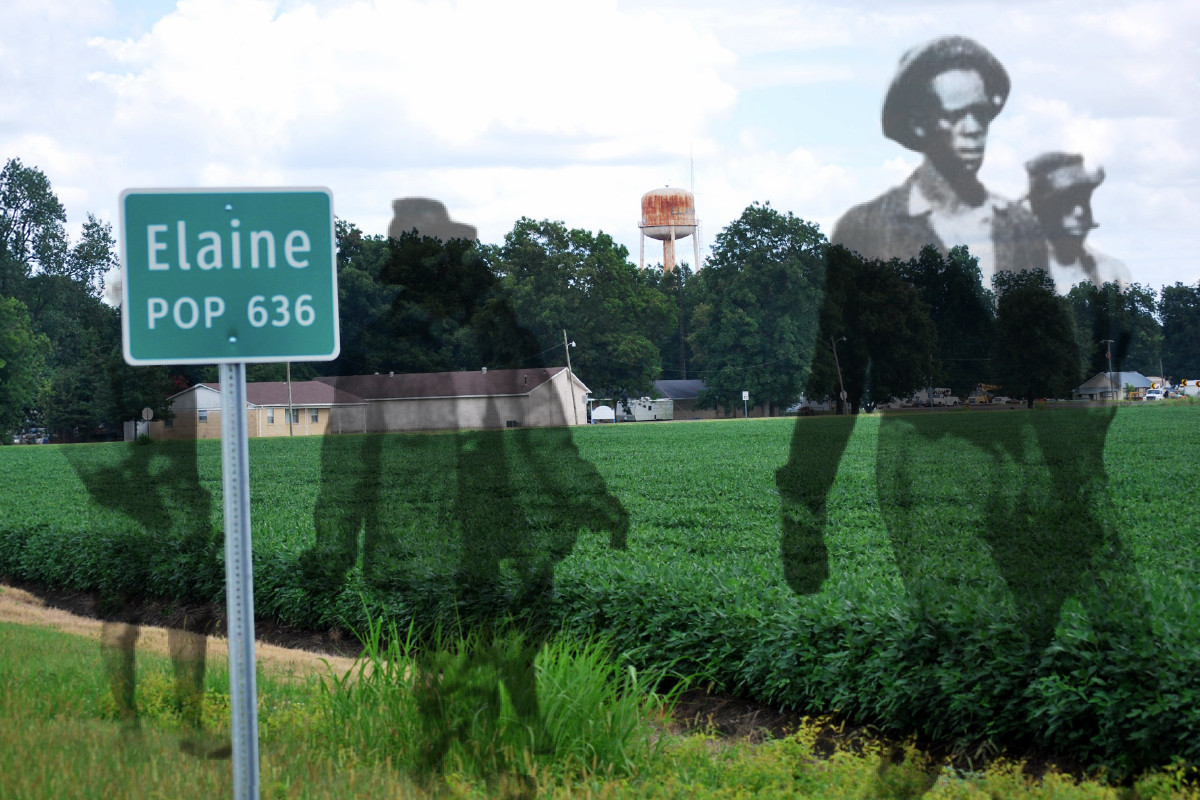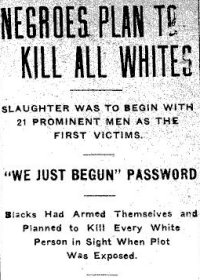Tree planted in honor of Elaine massacre victims cut down
Source: Associated Press
Updated 7:01 am CDT, Monday, August 26, 2019
Photo: Noreen Nasir, AP
FILE - In this June 15, 2019, file photo, men work near a monument under construction honoring victims of the Elaine Massacre that sits across from the Phillips County courthouse in Helena, Ark. Officials are investigating after someone cut down a willow tree that was planted to honor the victims of the 1919 Elaine massacre in eastern Arkansas. The Elaine Legacy Center says the tree was chopped down at its base last week and a memorial tag was stolen.
ELAINE, Ark. (AP) — Officials are investigating after someone cut down a willow tree that was planted to honor the victims of the 1919 Elaine massacre in eastern Arkansas.
The Elaine Legacy Center says the tree was chopped down at its base last week and a memorial tag was stolen. Memphis, Tennessee, television station WMC reports that police and state parks officials are investigating.
The tree was planted in April in remembrance of the victims of the massacre, which was one of the largest racial mass killings in U.S. history. It occurred during the summer of 1919, when hundreds of African Americans died at the hands of white mob violence during the "Red Summer."
Events are planned for later next month to mark the 100th anniversary of the massacre in Arkansas.
Read more: https://www.chron.com/news/us/article/Tree-planted-in-honor-of-Elaine-massacre-victims-14378234.php
(Short article, no more at link.)

Judi Lynn
(160,525 posts)The Massacre of Black Sharecroppers That Led the Supreme Court to Curb the Racial Disparities of the Justice System
White Arkansans, fearful of what would happen if African-Americans organized, took violent action, but it was the victims who ended up standing trial

Elaine Defendants, Helena, Phillips County, Ark., ca. 1910, (Butler Center for Arkansas Studies, Bobby L. Roberts Library of Arkansas History and Art, Central Arkansas Library System)
By Francine Uenuma
smithsonian.com
August 2, 2018
The sharecroppers who gathered at a small church in Elaine, Arkansas, in the late hours of September 30, 1919, knew the risk they were taking. Upset about unfair low wages, they enlisted the help of a prominent white attorney from Little Rock, Ulysses Bratton, to come to Elaine to press for a fairer share in the profits of their labor. Each season, landowners came around demanding obscene percentages of the profits, without ever presenting the sharecroppers detailed accounting and trapping them with supposed debts.
“There was very little recourse for African-American tenant farmers against this exploitation; instead there was an unwritten law that no African-American could leave until his or her debt was paid off,” writes Megan Ming Francis in Civil Rights and the Making of the Modern American State. Organizers hoped Bratton’s presence would bring more pressure to bear through the courts. Aware of the dangers – the atmosphere was tense after racially motivated violence in the area – some of the farmers were armed with rifles.
At around 11 p.m. that night, a group of local white men, some of whom may have been affiliated with local law enforcement, fired shots into the church. The shots were returned, and in the chaos, one white man was killed. Word spread rapidly about the death. Rumors arose that the sharecroppers, who had formally joined a union known as the Progressive Farmers and Household Union of America (PFHUA) were leading an organized “insurrection” against the white residents of Phillips County.
Governor Charles Brough called for 500 soldiers from nearby Camp Pike to, as the Arkansas Democrat reported on Oct 2, “round up” the “heavily armed negroes.” The troops were “under order to shoot to kill any negro who refused to surrender immediately.” They went well beyond that, banding together with local vigilantes and killing at least 200 African-Americans (estimates run much higher but there was never a full accounting). And the killing was indiscriminate—men, women and children unfortunate enough to be in the vicinity were slaughtered. Amidst the violence, five whites died, but for those deaths, someone would have to be held accountable.
Read more: https://www.smithsonianmag.com/history/death-hundreds-elaine-massacre-led-supreme-court-take-major-step-toward-equal-justice-african-americans-180969863/#uTtiFtELImHaIhiW.99
Judi Lynn
(160,525 posts)July 29, 2019

In this June 15, 2019, photo, a man works near a monument under construction honoring victims of the Elaine Massacre that sits across from the Phillips County courthouse in Helena, Ark. The Elaine Massacre Memorial is set to be unveiled in September.
ELAINE, Ark. (AP) — J. Chester Johnson never heard about the mass killing of black people in Elaine, a couple hours away from where he grew up in Arkansas. Nobody talked about it, teachers didn’t mention it in history classes, and only the elderly remembered the bloodshed of 1919.
He was an adult when he found out about it. By then, his grandfather, Alonzo “Lonnie” Birch, was dead — perhaps taking a secret to his grave.
Johnson believes Birch took part in the Elaine massacre. And now he’s bent on telling the story of one of the largest racial mass killings in U.S. history, an infamous chapter in the “Red Summer” riots that spread in cities and towns across the nation.
“I feel an obligation,” said Johnson, who is white. “It’s hard to grow up in a severely segregated environment and for it not to affect you. If you don’t face it and deal with it in various ways, it becomes undiscovered.”
___
EDITOR’S NOTE: Hundreds of African Americans died at the hands of white mob violence during “Red Summer” but little is widely known about this spate of violence a century later. As part of its coverage of the 100th anniversary of Red Summer, AP will take a multiplatform look at the attacks and the communities where they occurred. https://www.apnews.com/RedSummer
___
Johnson, who now lives in New York City, is co-chair of a committee overseeing construction of a memorial honoring those killed in 1919. He and others are hoping the structure, being built in a park across from the Phillips County Courthouse about a half-hour drive from Elaine, will bring attention to the massacre. Others say plans for a monument are a folly — starting with its location — and want commemoration efforts to focus instead on reparations to account for what they say was theft of black-owned land in the wake of the killings.
“It was literally a war on this area. People wanted the property that was almost all black-owned,” said Mary Olson, who is white. She is president of the Elaine Legacy Center, a red-brick community center that works to preserve the area’s civil rights history. It bears the sign, “Motherland of Civil Rights.”
The violence unfolded on the evening of Sept. 30, 1919, as black sharecroppers had gathered at a small church in Hoop Spur, an unincorporated area about 2½ miles north of Elaine. The sharecroppers, wanting to be paid better and treated more fairly, were meeting with union organizers when a deputy sheriff and a railroad security officer — both white — arrived.
Fighting and gunfire erupted, though it’s still not clear who shot first. The security officer was killed and the deputy wounded.
White men frustrated that the sharecroppers were organizing went on a rampage. Over several days, mobs from the surrounding area and neighboring states killed men, women and children.
More:
https://www.jchesterjohnson.com/blog
Judi Lynn
(160,525 posts)Red Summer
The Elaine massacre began on September 30–October 1, 1919 at Hoop Spur in the vicinity of Elaine in rural Phillips County, Arkansas. An estimated 100 to 237 black people were killed, along with five white men. According to the Encyclopedia of Arkansas, "the Elaine Massacre was by far the deadliest racial confrontation in Arkansas history and possibly the bloodiest racial conflict in the history of the United States".[4][5].
Because of the widespread white mob attacks on blacks during this period of racial terrorism of black citizens, in 2015 the Equal Justice Initiative of Montgomery, Alabama classified the black deaths as lynchings in their report on lynching of African Americans in the South.[6]

. . .
Located in the Arkansas Delta, Phillips County had been historically developed for cotton plantations, and was worked by African-American slaves before the Civil War. In the early 20th century the population was still overwhelmingly black, as most freedmen and their descendants had stayed as illiterate farm workers and sharecroppers.
African Americans outnumbered whites in the area around Elaine by a ten-to-one ratio, and by three-to-one in the county overall.[4] White landowners controlled the economy, selling cotton on their own schedule, running high-priced plantation stores where farmers had to buy seed and supplies, and settling accounts with sharecroppers in lump sums, without listing items.[4]
The Progressive Farmers and Household Union of America had organized chapters in the Elaine area in 1918-19. On September 29, representatives met with about 100 black farmers at a church near Elaine to discuss how to obtain fairer settlements from landowners. Whites had resisted union organizing by the farmers and often spied on or disrupted such meetings. In a confrontation at the church, a county deputy was shot and killed, and another white man wounded.
More:
https://en.wikipedia.org/wiki/Elaine_race_riot
Mersky
(4,980 posts)The harsh history that precedes us.
The current of meanness that we face shouldn't just run over us. If we stand up, the waters wouldn't even reach to our knees.
I started to write this comment yesterday, but I couldn't quite muster many real words. Fits and starts at moments, all I could do is breathe and figure out what I could do about it. The tree being cut down, that shouldn't have happened. Not in 2019 in Arkansas along the Mississippi.
What I did was meager, but something of a start: I told aloud the events in Elaine from 1919 and 2019 to a friend in my inner circle, to bring it out of virtual realm. I will share it out further in an effort to inform and reflect on what we can do to support a true and loving egalitarian society that values the beauty of the diversity that is humankind.
Plant another tree. I hope they plant another tree. I'd like to help plant 237 trees in Elaine, in this year of 2019. That feels like a real starting place to me.